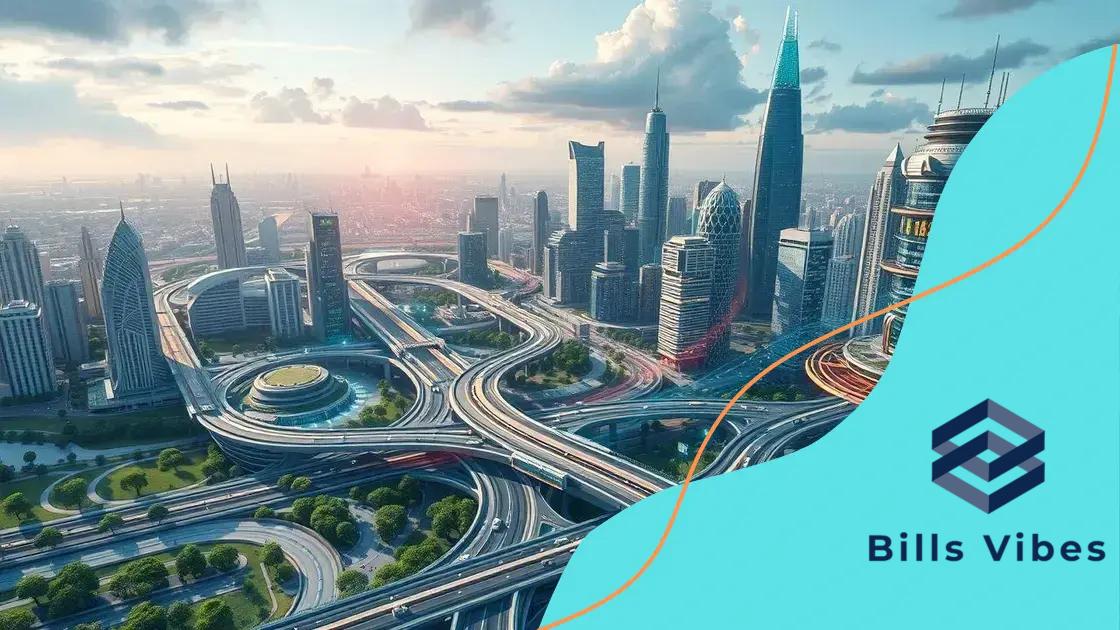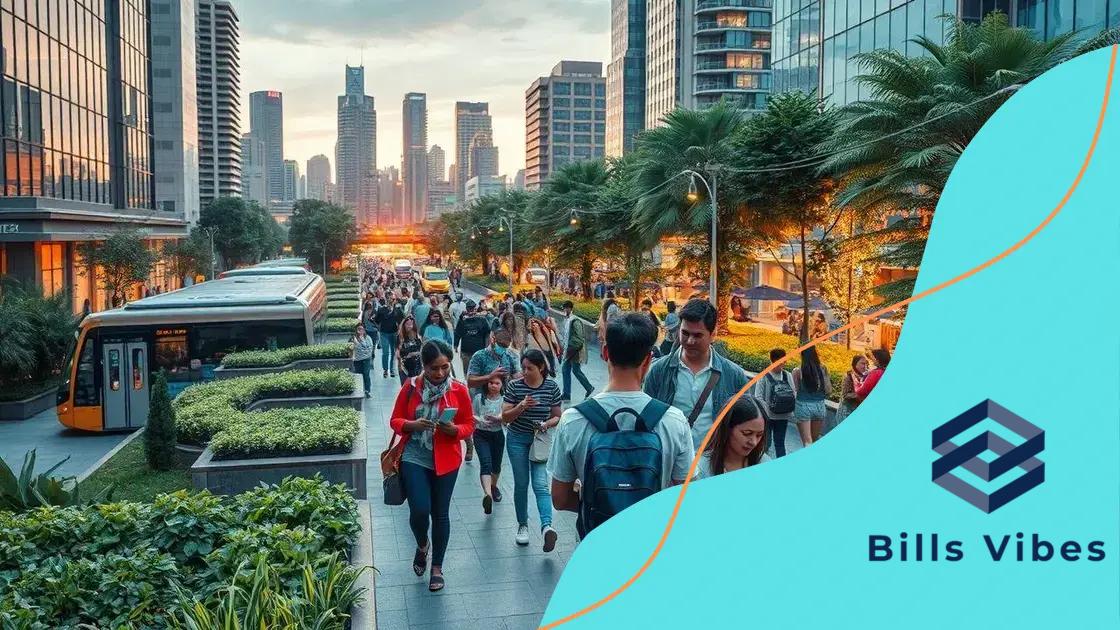Smart cities expansion: shaping the future of urban living

Smart cities utilize advanced technology and data to enhance urban living through improved public safety, sustainable practices, and optimized services, creating smarter, more efficient environments for residents.
Smart cities expansion is changing how we interact with urban environments. Ever thought about how technology can enhance our daily lives in the city? Let’s dive into this fascinating development.
Understanding smart cities and their importance
Understanding smart cities is key to grasping how technology transforms urban environments. These cities leverage digital tools to enhance the quality of life for their residents.
A smart city integrates various technologies to manage resources efficiently, improving everything from traffic flow to energy consumption. For residents, this means easier access to services and a healthier living environment.
Core Features of Smart Cities
One of the main goals of smart cities is to create a sustainable future. By using data and technology, they aim to reduce their environmental footprint. Here are some vital features:
- Intelligent transportation systems
- Efficient waste management
- Smart energy solutions
- Advanced healthcare services
The use of Internet of Things (IoT) devices plays a central role in these features. They allow real-time data collection, which helps cities adapt quickly to changing needs. For example, smart streetlights can adjust brightness based on traffic and pedestrian presence.
Moreover, the community benefits significantly. Enhanced public safety, always-connected citizens, and improved emergency responses are just a few examples showcasing how smart cities enhance urban life.
Importance of Smart Cities
The importance of smart cities can’t be overstated. They address urban challenges such as congestion, pollution, and resource scarcity. By implementing innovative solutions, they help cities become more resilient and adaptive.
A smart city not only focuses on the technology itself but also involves citizens in decision-making. This engagement fosters a sense of community and encourages collaboration for better living conditions.
Key technologies driving smart cities
Key technologies play a crucial role in shaping smart cities. These advancements help cities manage resources efficiently and provide better services to their citizens. Understanding these technologies helps us appreciate their impact on urban living.
One of the most significant technologies is the Internet of Things (IoT). IoT connects devices and systems, allowing for seamless communication and data sharing. This connectivity is essential for managing everything from transportation to energy use.
Smart Sensors
Smart sensors are vital components of smart cities. They collect data about various urban activities. These include:
- Traffic flow and congestion
- Environmental conditions
- Public safety inputs
With this data, cities can make informed decisions that enhance urban life. For instance, traffic management systems can adapt in real-time, reducing congestion and improving air quality.
Data Analytics
Data analytics is another cornerstone of smart cities. By analyzing data from multiple sources, city planners can spot trends and identify issues. This proactive approach helps maintain city infrastructure and improve service delivery.
As cities continue to evolve, the use of artificial intelligence (AI) also becomes more prevalent. AI can optimize energy consumption and improve public transport systems. It can also enhance services like waste management by predicting when bins will be full.
Moreover, mobile apps are increasingly used to keep residents informed. These apps provide real-time updates on public transport, safety alerts, and community events. This fosters greater engagement between citizens and their city.
Benefits of smart cities for residents

The benefits of smart cities for residents are numerous and impactful. These cities use technology to enhance various aspects of urban life, making daily activities easier and more efficient.
One major advantage is improved public safety. With advanced surveillance systems and smart lighting, cities can reduce crime rates and increase residents’ sense of security. Information is more accessible, empowering citizens to stay informed about potential dangers.
Enhanced Transportation
Transportation is another area where smart cities shine. Innovative traffic management systems and real-time public transport updates make commuting smoother. For example:
- Reduced traffic congestion
- Quicker public transportation options
- Improved pedestrian pathways
These features lead to shorter travel times and less frustration for commuters. Moreover, real-time data helps residents choose the best routes, saving time and energy.
Environmental Benefits
Smart cities also focus on sustainability. By using sensors and data, cities can manage resources more effectively. This includes:
- Optimized energy use
- Efficient waste management
- Improved air quality monitoring
Residents enjoy a cleaner environment as cities find ways to reduce waste and lower emissions. Access to clean energy resources contributes to overall improved living conditions.
Another significant benefit is enhanced community engagement. Smart cities encourage participation through digital platforms. Residents can voice concerns, provide feedback, and take part in community projects. This fosters a sense of belonging and ownership.
Challenges faced during smart cities expansion
Expanding smart cities brings exciting possibilities but also presents various challenges. Understanding these obstacles is crucial for cities aiming to use technology effectively.
One significant challenge is the high cost of implementation. Integrating advanced technologies requires substantial investment in infrastructure. Many cities struggle to find the necessary funding, which can delay projects.
Data Privacy Concerns
Another major hurdle involves data privacy. With all the information collected from residents, ensuring security is essential. There are risks of data breaches that can compromise personal information. Cities must put robust security measures in place to protect their citizens.
Technological Integration
Moreover, integrating various technologies can be complex. Smart systems need to work seamlessly together, which demands collaboration between different stakeholders. Coordinating efforts among government agencies, private companies, and the community can be daunting.
Additionally, keeping up with fast-paced technological changes is another concern. As new innovations emerge, cities must stay updated and adapt accordingly. This constant evolution can strain city resources and planning.
Public resistance is also a challenge. Citizens may feel uncertain about new technologies and their implications. Ensuring that residents understand and support smart city initiatives is vital for successful implementation. Transparent communication and community engagement can help overcome this resistance.
Finally, addressing inequality must not be overlooked. As cities expand smarter, they need to ensure that all residents benefit from these advancements. Bridging the digital divide is crucial to avoid leaving any community behind.
Future trends in urban development
Future trends in urban development are shaping how cities will look and function in the coming years. With rapid technological advancements, cities are becoming smarter and more efficient.
One of the most exciting trends is the rise of green buildings. These structures are designed to minimize environmental impact, using sustainable materials and energy-efficient systems. They contribute to a healthier urban environment and often incorporate green spaces that improve air quality.
Smart Infrastructure
Smart infrastructure is another key trend, utilizing technology to enhance city functions. This includes:
- Smart grids for improved energy distribution
- Automated waste management systems
- Intelligent transportation networks
These innovations not only improve efficiency but also enhance the quality of life for residents. For instance, smart traffic lights can adjust based on real-time traffic conditions, reducing congestion.
Mixed-Use Development
Mixed-use development is gaining popularity as well. This approach combines residential, commercial, and recreational spaces into one area. It promotes walkability and reduces the need for long commutes, which is beneficial for the environment. Residents can live, work, and play in the same vicinity, fostering a sense of community.
Additionally, cities are focusing on enhancing public spaces. Parks, plazas, and community areas are being redesigned to promote social interaction. As residents increasingly value outdoor experiences, improving these spaces becomes essential.
Finally, the use of data analytics in urban planning is transforming how cities grow. Planners are using data to make informed decisions, ensuring that developments align with the needs of the community. By analyzing trends, cities can adapt and evolve more effectively.
FAQ – Frequently Asked Questions about Smart Cities and Urban Development
What are smart cities?
Smart cities use technology and data to improve urban living, enhancing services like transportation, energy management, and public safety.
How do smart cities benefit residents?
Residents enjoy improved public safety, enhanced transportation options, and better access to services, leading to a higher quality of life.
What challenges do cities face when becoming smart?
Cities face challenges like high implementation costs, data privacy concerns, and ensuring community engagement.
What is the future trend in urban development?
Future trends include sustainable practices, smart infrastructure, and the integration of mixed-use developments promoting walkability and community.
How can community engagement enhance smart city initiatives?
Community engagement ensures that residents have a voice in urban planning, making projects more relevant and successful.






